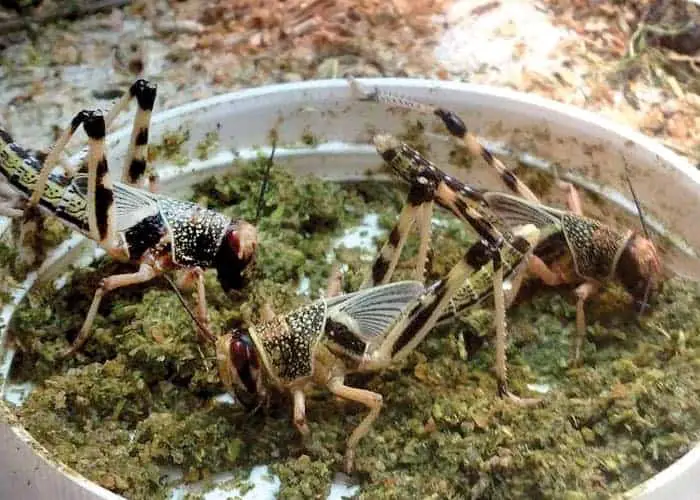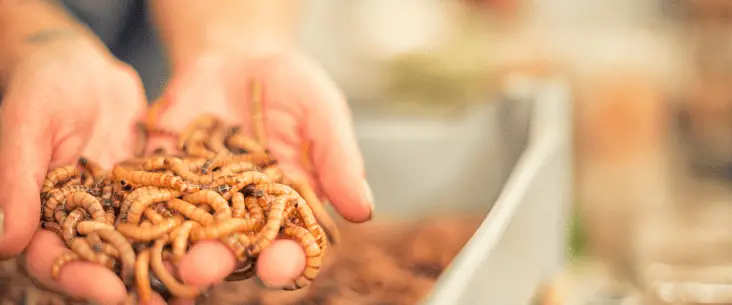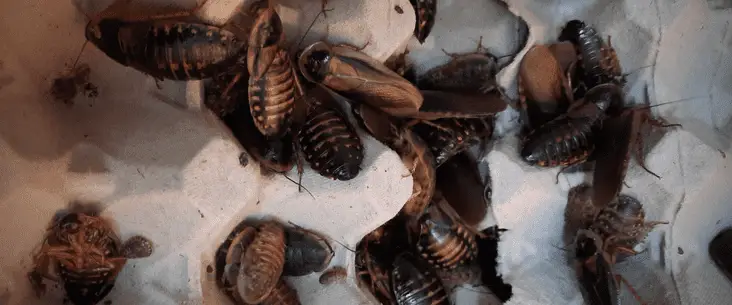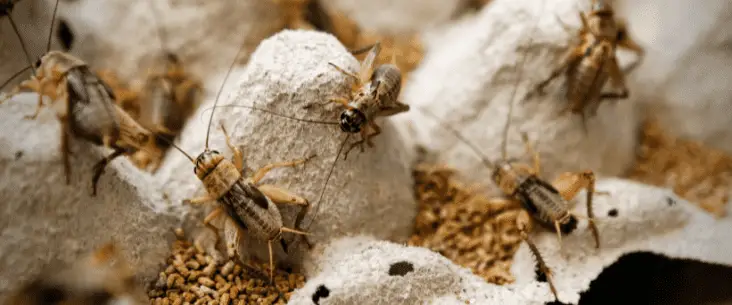Feeder locusts are a great food for many different animals. Pet animals such as bearded dragons and other reptiles, but also tarantulas and praying mantis just love locusts as food. Locusts can be bought at many exotic pet shops. However, many have experienced they quickly die and are useless to feed anymore. In this article, we will look at how you can keep feeder locusts alive much longer.
You can keep feeder locusts alive by providing it with good housing, proper ventilation, and give them nutritious foods that also hydrates them. Feeder locusts are animals too and need proper care to use them as food for other animals.
Have you ever considered how long it takes the journey from the locust breeder to your home? And that it is living to whole time in a small plastic box with limited food. Feeder locusts need proper care as well to make them useful as food and keep them alive for much longer.
Caring for feeder locusts: 4 essential steps
It takes around two to three weeks before locusts are at your home from a breeder (unless your buy them directly from a locust breeder of course). They are transported in small plastic containers and are not cared for within these weeks. So when you buy them, you immediately have to do some steps to keep them healthy and alive.
#1 Housing your feeder locusts
Firstly, they need to be moved into a better and spacier container. It can be as simple as a Tupperware box, but you need to consider these basic features.
The container has to have a size of at least 20cm x 30cm x 20cm (8″ x 12″ 8″) for around 20 locusts. They need to be able to move around, climb and find shelter. A higher container makes it easier to take care of. They don’t jump out that easily and you can make more climbing opportunities for them.
Yes, locusts can jump very well (and adult ones even fly short distances), so you need a lid on your container to seal it off. But, there needs to be enough airflow, so good ventilation holes are significant to have. When you buy a Tupperware or other small plastic box with lid, drill many tiny holes in the lid (small enough so the locusts can’t go through). Or drill large ones that are covered with fine wired metal mesh.
Do you like it the easy way? The ‘Faunarium‘ box from Exo Terra or the ‘Lee’s Kritter Keeper‘ is perfect for keeping in locusts, and is still quite cheap. It has all the features to keep locusts alive for a long time.
Important! Never keep the in the original container wherein you bought them. This container is far too small to keep them healthy and alive. It will result in the death of many locusts, which are of no use when you want to feed your pet animal.
#2 Set up your container
Provide some shelter and climbing opportunities. Paper toilet rolls and egg flats/egg cartons are perfect to use for this. They are clean and dry, easily replaced and refreshed, and very cheap or free to obtain.
Just place some of them in the container, but keep one spot clear to provide food. Don’t place (moist) food on the carton. The carton gets wet, dirty, and mould will start to grow.
You can also use dry twigs from them to climb and sit on or place some wire mesh folded into a triangle-shaped structure, to provide them with some climbing opportunities.
Locusts don’t need any substrate in their container and only makes it more work to keep the container clean.
#3 Provide a proper environment
Locusts should be kept quite dry and warm. Room temperature (20°C/68°F) is fine, but warmer is better (around 26°C/79°F). Feeder locusts (migratory locusts and desert locusts) are arid/desert species, and they slowly grow or even die when kept too cold.
A humidity of around 50% to 60% is perfect for them. It is not good to keep them moist or wet. They breathe through small holes along its body, and with condensation and water built-up, these holes will clog, obstructing the animal from breathing. It also causes the growth of mould quicker.
However, an environment that is too dry will give problems with moulting. They need a certain amount of humidity to remove themselves from their old skin. Of they get stuck or partially moulted, they will get problems and sooner or later will die.
#4 Feed nutritious food to your feeder locusts
Your feeder locusts need food, otherwise, they won’t last long. Feeding them keeps them healthy and alive, but also hydrates them. You don’t need to provide a water dish or other water source. They will get water from their food source. Food sources that can be used are grasses, plant leaves and vegetables.
Besides that food keeps them healthy, it also makes them a more nutritious food source. This process is called gut-loading, which actually means you provide food that converts the insect into good food for the animal that eats the locust.
Want to breed your own feeder locusts at home?
When you wish to breed your own feeder locusts at home, there is much more to learn than is discussed in this article. Check out our breeding guide for feeder locusts to learn the best and most effective methods of how you can breed your own feeder locusts at home. You’ll never have to buy them again!

What do you feed feeder locusts?
But what should feed your locusts? Several products work very well. I have good experience with fine-leaved bamboo. They eat it like there life depends on it. But bamboo is not available to everyone, and certainly not the amount that they need whole year around.
Other products that work well are grasses. Fresh cut grass, especially the long grass stems, are eaten very well by locusts. Vegetables can also be fed. Carrots and endive are eaten quite well and contain a lot of moisture to keep them hydrated.
The amount your need to feed must be found by trying. You can’t easily be overfeeding them, but not enough food is not healthy. Food needs to be available at all times and be refreshed at least every other day (but daily is even better).
Some power food such as Arcadia InsectFuel or powdered chicken breeding meal is also advised to keep them healthy, but also to make them really nutritious as feeder insects. We feed them around 0,5 grams of power food for every adult locusts.
Why do my locusts keep dying?
There are 4 main reasons your locusts die prematurely (or before you feed them to other animals), which can actually be fixed quite easily. Normally, a locust can survive for at least 4 months when you buy them as adults and longer when you buy smaller sized locusts.
So, when you have locusts that keep dying you need to check these 4 issues:
- Dehydration: Because they don’t need a water dish doesn’t mean they can’t get dehydrated. They still need moist, so feed them also food that contains enough moisture. Fresh leaves, grasses or vegetables provide enough moisture to keep them hydrated.
- Bad moulting: Although you need to keep them dry, they still need some humidity to successfully make them moult. Humidity below 50% can give problems for them, where they get stuck in their old skin or only partially moult. Eventually, this will result in the death of your locusts. When the humidity is (too) low, you can place a toilet paper roll that is mist sprayed with water outside the container! It will slowly release the absorbed moisture and increase the humidity. However, don’t overdo it, because too much moisture will cause other problems.
- Mould growth: When you don’t refresh the food enough or keep the container too humid, mould can start growing. Mould is very unhealthy for locusts and can kill your animals. When you see mould start to grow, remove it as soon as possible. When it is on an object, remove it from the enclosure and throw it away/clean it thoroughly. If it is on the container’s wall, remove the locusts into a temporary container and clean the enclosure (only with organic soap and water, not with heavy chemicals!).
- Parasites: Locusts can get parasites. This is not immediately problematic, but when they die from it, and other locusts eat them (yes they do…) the parasites will slowly spread among all your locusts. If you feed them enough food, they won’t eat from each other. Also, remove dead locusts as quickly as possible.
If you follow the steps in this article, you probably won’t have to deal with these issues. The locusts will be healthy and stay alive much longer, and almost only die of old age.
Want to know more?
If you like to know more about the care of feeder insects, check out our general guide for the care of feeder insects.
When you wish to breed your own feeder locusts at home, there is much more to learn than is discussed in this article. Check out our breeding guide for feeder locusts to learn the best and most effective methods of how you can breed your own feeder locusts at home.
Share this page!



